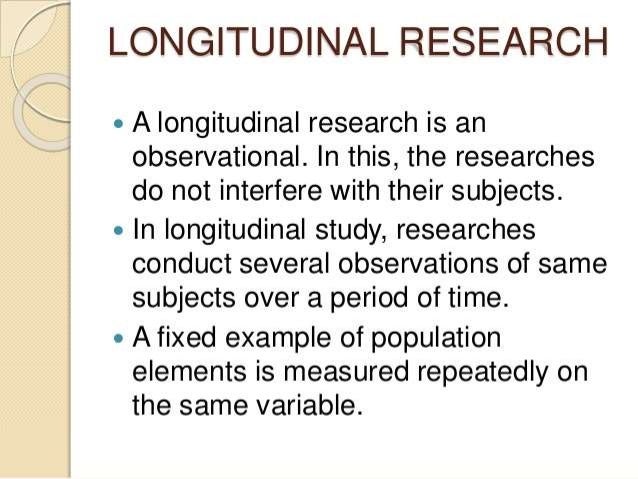Table Of Content

They can range from as short as a few weeks to as long as several decades. Overall, researchers need to test for and control cohort effects which could otherwise lead to invalid conclusions. They are beneficial for recognizing any changes, developments, or patterns in the characteristics of a target population. Longitudinal studies are often used in clinical and developmental psychology to study shifts in behaviors, thoughts, emotions, and trends throughout a lifetime.
When Would You Use a Longitudinal Study?
Such a study needed to be a longitudinal survey since you can only understand the effects of aging en masse by considering the results over time. The results from this study are being used in areas like cardiovascular research and preventable hospitalizations. In cohort studies, researchers merely observe participants without intervention, unlike clinical trials in which participants undergo tests. Firstly it was a study carried out in a single population in a single town, bringing into question the generalisability and applicability of this data to different groups. However, Framingham was sufficiently diverse both in ethnicity and socio-economic status to mitigate this bias to a degree.
Longitudinal Designs
For this reason, researchers using this approach typically recruit many participants, expecting a substantial number to drop out before the end. Not only is it a struggle to recruit participants, but subjects also tend to leave or drop out of the study due to various reasons such as illness, relocation, or a lack of motivation to complete the full study. Recall bias occurs when participants do not remember past events accurately or omit details from previous experiences. Studentsshould always cross-check any information on this site with their course teacher.
Get more of your customers to share their current, honest thoughts with you!
A longitudinal cohort study is one in which we study people who share a single characteristic over a period of time. Cohort studies are regularly conducted by medical researchers to ascertain the effects of a new drug or the symptoms of a disease. Longitudinal studies and cross-sectional studies are two different types of research design. In a cross-sectional study you collect data from a population at a specific point in time; in a longitudinal study you repeatedly collect data from the same sample over an extended period of time. While longitudinal studies repeatedly observe the same participants over a period of time, cross-sectional studies examine different samples (or a ‘cross-section’) of the population at one point in time. They can be used to provide a snapshot of a group or society at a specific moment.
How long is a longitudinal study?
Like Sonia, her preferences for eggs changed since she watched the documentary. Consider a study conducted to understand the similarities or differences between identical twins who are brought up together versus identical twins who were not. The study observes several variables, but the constant is that all the participants have identical twins.

Types of longitudinal studies
A cross-sectional study is a type of observational study in which the researcher collects data from variables at a specific moment to establish a relationship among them. On the other hand, longitudinal research observes variables for an extended period and records all the changes in their relationship. A longitudinal study is a research conducted over an extended period of time. It is mostly used in medical research and other areas like psychology or sociology. This chapter addresses the peculiarities, characteristics, and major fallacies of longitudinal research designs.
Like the Up series, it aims to study the life trajectories of a group of British children relative to the socio-economic and demographic changes occurring in Britain. The study has provided researchers with several interesting insights into what constitutes the human quality of life. The study is conducted in the form of interviews in which the subjects report the changes that have occurred in their lives in the last 7 years since the last interview. The thing to remember when thinking about what a longitudinal study is is that they can have broad objectives.

These research studies can last as short as a week or as long as multiple years or even decades. Unlike cross-sectional studies that measure a moment in time, longitudinal studies last beyond a single moment, enabling researchers to discover cause-and-effect relationships between variables. For example, some longitudinal studies have explored differences and similarities among identical twins, some reared together and some apart.
External links
In the 18th century, Count Philibert Gueneau de Montbeillard conducted the first recorded longitudinal study when he measured his son every six months and published the information in "Histoire Naturelle." For example, imagine that researchers are interested in the mental health benefits of exercise in middle age and how exercise affects cognitive health as people age. The researchers hypothesize that people who are more physically fit in their 40s and 50s will be less likely to experience cognitive declines in their 70s and 80s. In particular, the study attempts to track patterns of substance abuse and mental health among the subjects and correlate them to the prenatal habits of the parents.
Thus, testing and controlling for retest effects are important considerations in longitudinal research. If unchecked in analysis, retest gains can be confused with genuine intraindividual change or interindividual differences. To estimate retest effects, performance of retested groups is compared to groups taking the test for the first time.
They can also be particularly useful for ascertaining consumer trends if you’re trying to research consumers with a specific common characteristic. An example of such a study would be observing the choice of cereal for kids who go to Sunshine Elementary School over time. As for a formal definition, a longitudinal study is a research method that involves repeated observations of the same variable (e.g. a set of people) over some time. The observations over a period of time might be undertaken in the form of an online survey. It can be tremendously useful in a variety of fields to be able to observe behavior or trends over time.
Periodically, you collect the same types of data from the group to track their development. Because cross-sectional studies are shorter and therefore cheaper to carry out, they can be used to discover correlations that can then be investigated in a longitudinal study. While they are most commonly used in medicine, economics, and epidemiology, longitudinal studies can also be found in the other social or medical sciences.












